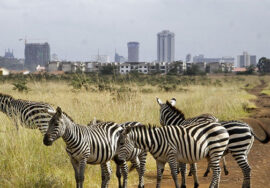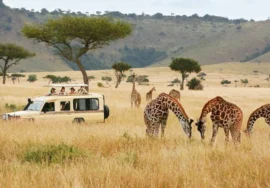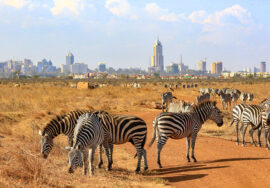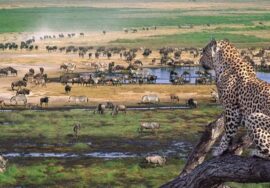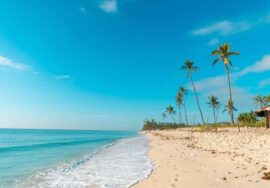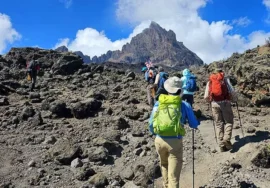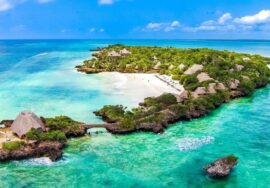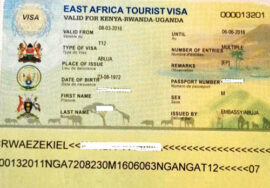
SGR Train Timetable & Schedule
The latest thing that has made Kenyans love their trains even more is riding the high-tech Madaraka Express. Visitors and safari-goers can take this modern train from Nairobi to the warm coast of Kenya in record time. Along the way, it goes through two national parks.
Imagine sitting back in the cool comfort of your air-conditioned train car and looking out the big windows at the passing scenery. But not just any fields. The trip takes you through the famous Tsavo East and West National Parks, where you might see elephants, giraffes, and even lions and cheetahs. This is such a pristine way to go on an African tour.
An Quick Answer
The current standard gauge railway (SGR), which was built with help from the Chinese government, took the place of the sometimes unreliable “Lunatic Express,” a train built by the British in the 19th century during the colonial era.
The word “Madaraka” in Swahili means “freedom,” which is also the name of the country’s newest train line. It takes about 6 hours to get from the capital to the coast at speeds of 120 km/h (75 mph). That’s a big difference from the 16 to 20 hours of the last one.
The 3.8-billion-dollar train has all the modern comforts, such as wide, comfortable seats with charging stations, free WiFi, and a buffet car with snacks and sandwiches. Plus, there are places set aside for your luggage that are safe.
A Safari by Train?
It may be easiest to get to the coast or the city by taking the Madaraka Express. This way, you can still see the wildlife and heartland of Kenya. However, you can use the fast train in a different way during your trip.
You can go on a journey with Safari Trips to Kenya in one of our 4×4 Jeeps to one of Kenya’s great wildlife parks, like the Masai Mara, Amboseli, or Tsavo. You can then finish your trip on the Express, which goes to the coast. Several stops are close to the parks and are easy to get to.
As you travel through the Tsavo Parks in comfort (with air conditioning), keep an eye out for the many elephants and other animals that walk these stately plains. The track of the train is raised for safety reasons, and it gives you a better view of the grassland and all the animals that live there.
As soon as the train gets to Mombasa, it stops at a modern station with shops, bars, and lounges. We can send a driver to meet you there and take you to your hotel or cottage.
What a change from the colonial train that brought Kenya into the 21st century.
It was known about the Lunatic Express.
The British came up with the idea for the old train as they built their control over Africa in the 1800s. But the train’s appearance had roots that were even deeper and more mysterious.
A Kamba medicine woman named Syokimau said that this would happen: a long iron snake spewing fire and smoke would come from the Indian Ocean and move across the plains. He told stories about people from other countries with red, curly hair who would bring the snake and a lot of bad things, like stealing cattle and ruining the land.
And so it was, though not without a lot of hard problems. Work began in 1896, with an amazing price tag of 5 million pounds. From the beginning, the native people, the animals, and the rough terrain made it almost impossible for the British planners and the 32,000 Indian workers who were brought in to build the railway to get it done.
Over 2,500 building workers died during the five years it took to build. They died from accidents, sickness, attacks by lions, and attacks by local tribal people. Finally, in 1899, the Uganda Railway, which had just been given a new name, reached the small village of Nyrobi, which later became Nairobi, and train service started.
Online and on time
It took about two and a half years to finish the Madaraka Express. It started carrying freight on May 30, 2017, and people the next day.
The new train service is quick, safe, secure, and beautiful. It’s a big change from the days when steam engines blew smoke across iffy wooden trestle bridges. You can now use your phone to book your tickets online and pay for them.
Since then, the railroad has grown and now goes to thirteen different places. Every day, at 8:00 am, 3:00 pm, and 10:00 pm, three trains leave at the same time from Nairobi and Mombasa. The Night Train, on the other hand, is a fast train that doesn’t stop at any local stations.
It takes about five hours to get to the other side of the country.The track was called the Uganda Railway, the Permanent Way, and sometimes, in a mean way, the Lunatic Express. It was slow and shaky. Still, it turned into the main road for getting around the country. Along its path, towns sprung up, trade grew, and the railway met the needs of a country that was expanding. And Nairobi grew along with the country. It would soon become the center of the country.
Approximately 7,000 Indian workers who helped build the railway chose to stay in Kenya and started the first Indian communities in the country.
As the 21st century began, however, the train had become badly damaged, and trips to the coast took longer. It was time for a new, more modern train line that could carry people and goods faster and more reliably across the country and to the coast.
This was the start of the standard gauge Madaraka Express.
NAIROBI TO MOMBASA MADARAKA EXPRESS SGR TRAIN SCHEDULE
With stops at Emali, Mtito Andei & Voi
Nairobi to Mombasa Schedule (InterCounty)
| Nairobi (Intercounty) | Emali (Near Amboseli) | Mtito Andei (Tsavo West) | Voi (Tsavo East) | Mombasa |
| 8:00am | 9:27am/9:31am | 10:50am/10:51am | 12:02pm/12:08pm | 14:00pm |
Nairobi to Mombasa Schedule (Express)
| Nairobi (Express) | Emali (Near Amboseli) | Mtito Andei (Tsavo West) | Voi (Tsavo East) | Mombasa |
| 3:00pm (Afternoon Train) | – | – | 6:48pm | 8:30pm |
| 10:00pm (Night Train) | – | – | – | 3:35 am |
Mombasa to Nairobi Schedule (InterCounty)
| Mombasa | Voi (Tsavo East) | Mtito Andei (Tsavo West) | Emali (Near Amboseli) | Nairobi |
| 08:00am | 09:49am/09:55am | 11:18am/11:21am | 12:36pm/12:39pm | 14:10pm |
Mombasa to Nairobi Schedule (Express)
| Mombasa (Express) | Emali (Near Amboseli) | Mtito Andei (Tsavo West) | Voi (Tsavo East) | Nairobi |
| 3:00pm (Afternoon Train) | – | – | 4:36pm | 8:18pm |
| 10:00pm (Night Train) | – | – | – | 3:35 am |

